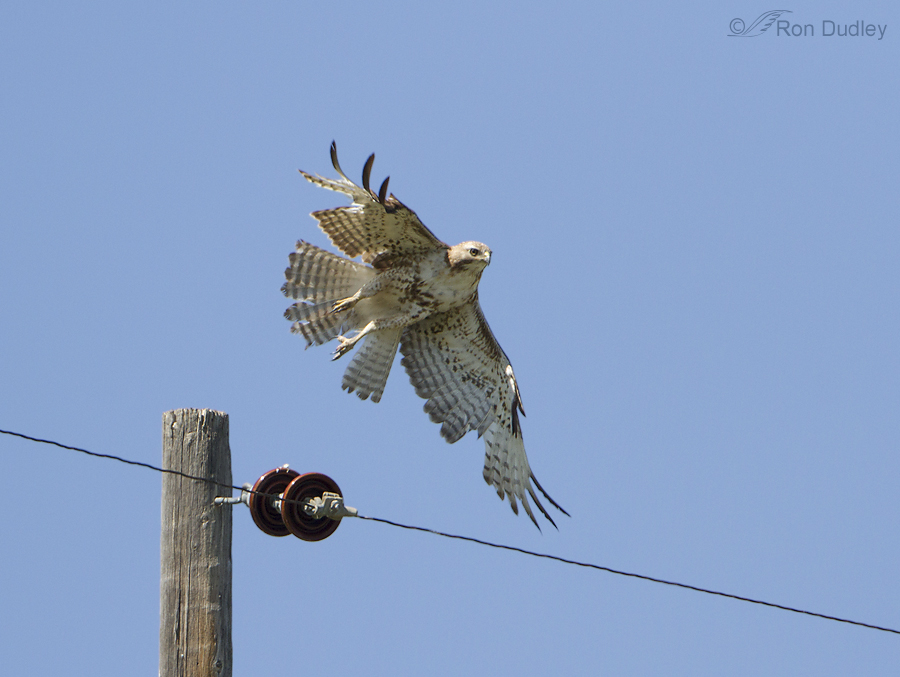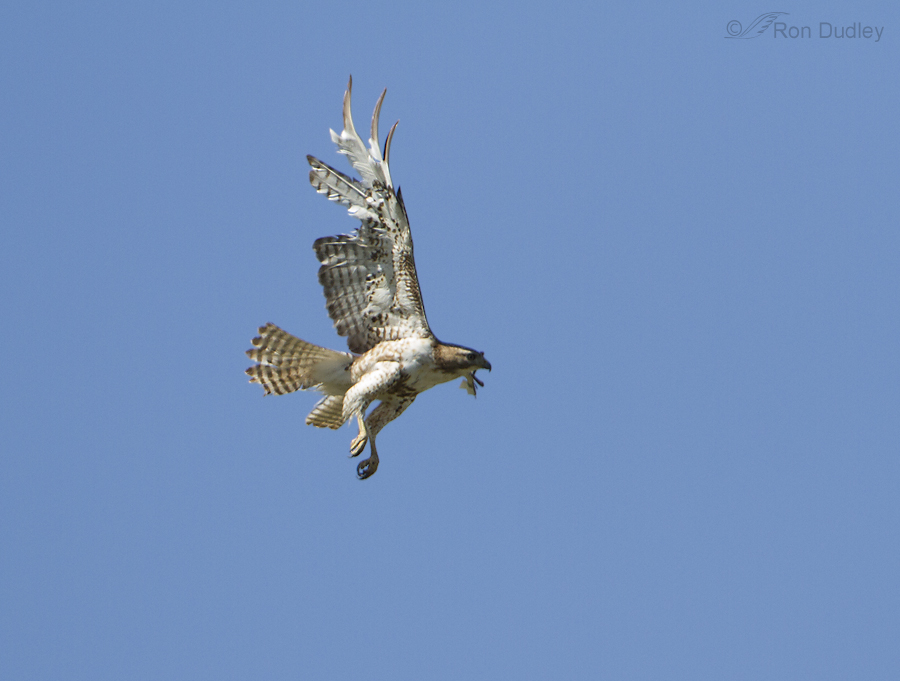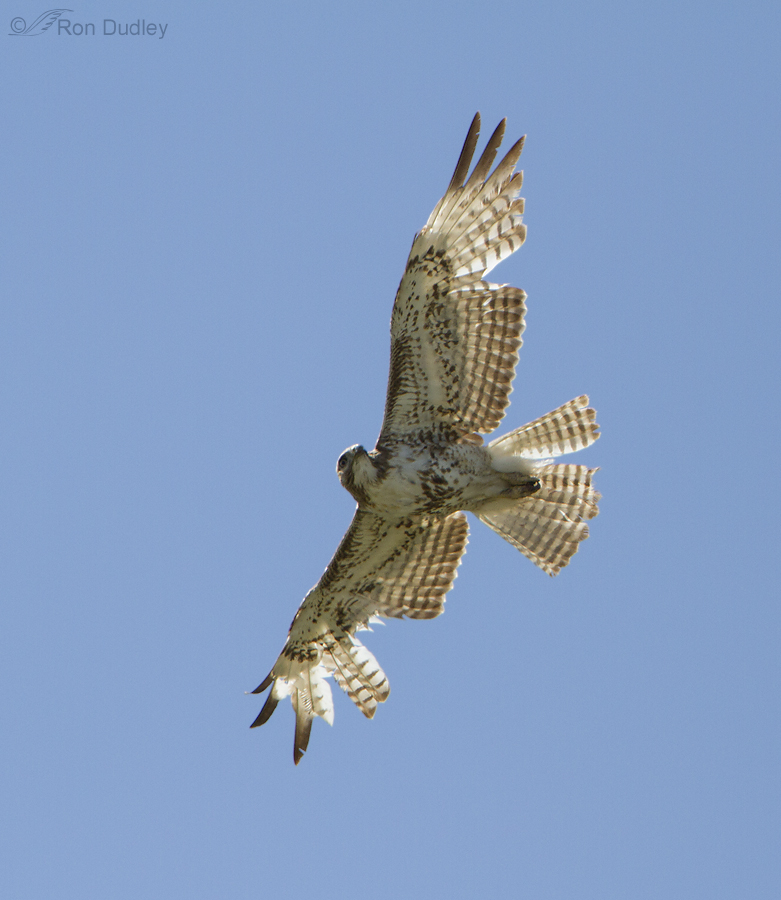This might just be the rattiest looking raptor I’ve ever encountered in the wild.
I found this juvenile Red-tailed Hawk three days ago in Box Elder County, Utah. It was too far away for good photos but even so I scoped it out with my lens for ID and to look for anything unusual.
Everything looked pretty normal until it took off when I noticed how very ragged its wings and tail looked.
I’ve seen many molting raptors but this one takes the cake. I’m actually surprised that it can fly.
After it took off it circled overhead a little closer to show a little more plumage detail.
I’ll admit to being mostly ignorant about molting patterns in raptors but I’m very curious about what’s going on with this bird. It was my understanding that the molt is typically much more gradual than this (especially in raptors, whose molt takes longer than it does in most other birds) so that the loss of feathers isn’t so extreme at any one time.
I also thought that raptor molt was usually symmetrical and bilateral with the bird losing corresponding feathers on both sides at the same time so that balance in flight is relatively unaffected. The loss of feathers on the right wing of this hawk seems extreme to me.
Some of you have much more experience with raptors than I – any idea what’s going on? Could this be within the range of “normal” molting patterns? Could it be a combination of molting and loss of feathers due to a fracas with another raptor or some other violent encounter?
I’d appreciate any thoughts you may have.
Ron





Ron,
I’ve seen this kind of thing in the Mediterranean, we call it Maltese Moult. I’m not saying that is what’s happening here, but if you had any photos of the bird where you could view the wings and tail from the top, and there were feathers sticking up at a right angle, then it would be indicative. http://birdlifemalta.blogspot.com/2013/10/john-thurnell-read.html
Lawrie
Ron: I’m very new here and after your comments about falconry and falconers will continue to respond to topics of mutual interest and refrain from engaging negative comments that are usually the result from people that know very little about the sport. (And I would think this blog is not for discussion of the value of falconry).
Some if not all the resulting feather issues of this RT are not those of a moult. Moulting feathers do not result in broken feathers nor is it caused by broken feathers. (Imping is the process of repairing broken feathers with replacement of part of the damaged feather. Falconers don’t pull broken feathers. That is a very risky practice that can result in damaged feather fallicals which can permenently cause no feather growth.)
Some of the visible “damage” to this birds feathers can be the result of what we call shock or stress marks. These marks are often the result of no food or very poor quality food during the growth phase of the feathers in question. Hawklets are growing their first flight feathers all at the same time. The only time this occurs in their life. So poor food/no food or some extreme occurance (stress) can disperse the resulting weaking of the flight feathers over much of the “body”. Feathers with stress marks are much weaker at the point of the marks. Often these weakened feathers break at those areas during normal activities. This could be the reason for some of the damage seen in your photos.
I’m not sure it is the cause of all the damage though. Flight feathers rely on a system to aid in the protection and strength of the wing feathers and tail feathers (rectrices). If the system is disrupted with some breakage other breakage often follows. Then there are birds that simply don’t seem to respect their feathers and damage results.
I’m not saying contact with some potential prey could not also be the primary cause or partial cause of some of this damage.
BTW there is a “normal” moult sequence (does vary between hawks and falcons) but there are also unusual moult patterns. I have trained dozens of RT to hunt (currently dealing with 3 and have witnessed some variety in moult patters).
Thanks very much for your experienced insight as to what’s going on here, William. I learn so much from my readers and falconers like yourself have been a big part of that.
However, I would disagree with your statement that “this blog is not for the discussion of the value of falconry”. Falconry has an effect on birds both good and bad and I think the sport is a valid point of discussion here, where appropriate. We’ve had many such discussions in the past.
This doesn’t look like any kind of molting I’ve ever seen. It looks like a younger, less experienced bird that tangled with the wrong “prey…and seems to illustrate the fact that the mortality rate in the young birds is so high. If an experienced falconer could capture this bird, he might be able to glue in some replacement feathers…they do that sometimes. It’s a “sport” I HATE,but they do know how to make repairs. We have an annual “Birds of Prey Day” in our area every June… with birds that are meant to soar wearing hoods, jesses and stuck on 4′ roosts. Sick!!!
Ron,
I’m new at learnig about hawks but have been watching a nesting pair and their offspring here in Central Florida for a couple of years. Your
photos, observations and the comments of your peers taught me a lot. Looking forward to sharing this with my children and looking upwards with my photography. Your work is inspirering. Thanks.
Welcome, Greg. I’m glad my blog has been helpful to you and a large part of that is what you call “the comments of my peers”. I too learn a lot from them. Good luck with your hawks and your photography.
My initial thought was that the damage looked more like “battle wounds” than moult.I’ve known similar (but never quite this drastic!)feather damage in some kites and eagles.
I don’t know the area (I’m in Australia), but I hope that bird is able to find easier prey in a safe place. I’m thinking cat, dog or other big bird attacks if the hawk is forced to hunt at lower level.
And if not? Natural attrition.
These feathers appear to be broken. My concern is that this bird will have to wait for molting before the new feathers can grow in. Unless maybe a raptor rescue can capture this bird and remove the broken feathers so the new ones can quickly grow back. I know if my parrot breaks a feather I will gently pull it out and the new feather quickly grows. Like you, I don’t know how this bird can fly and capture food. Hopefully his parents are still close by and can help him. Thank you for the great pics Ron. You have brought me a few interesting birds that I have never seen or heard of before. I really appreciate it.
Brother can you spare a feather! I’ve seen a couple of juve Red-tails* with extreme molt patterns similar to this, but I don’t think this bird is molting yet as mentioned in an earlier comment. Newly molted feathers come in with a symmetrical rounded edge. All the short feathers on this bird appear to be broken, but they mimic molt because they’re in the same general spots where molt might begin on juvenile RTs. It’s possible this bird is dealing with overly brittle feathers. It takes a lot of energy to create a feather and juvenile feathers that come in all at once are low quality compared to future adult feathers that come in a couple at a time over an extended period. Perhaps this bird’s already low quality plumage is suffering the effects of poorer than normal nutrition while in the nest, or maybe some other underlying condition.
The usual (but not always) molt pattern for a juve RT is: the most inner primary (P1) goes first, then the molt proceeds orderly outward towards the fingers. It’s common for the outer two primaries (P9 & P10) to be retained until the following year’s molt. The staggered secondary molt usually starts at S1, and often S5 and 12 as well. It’s not unusual to retain multiple secondaries until the following year. The tail almost always starts with the 2 central “deck” feathers (R1 left and right), then the outer pair (R6 left and right). The other pairs eventually go, but are more irregular in sequence. Unlike the flight feathers, the tail almost always completely molts the first time around. Hawks generally molt symmetrically, but some asymmetry is not at all uncommon.
At first glance I thought this bird was just an early molting juve because, again, the short feathers seem to be in the general areas where molt would start (P1 and S1 which are located side by side). But looking closer… besides all the broken shafts, some of these gaps are in the wrong place for a normal first molt. P7 on the right wing and R3 on the tail shouldn’t be gone before their neighbors. Don’t quote me on this one, but I believe the feathers with the broken shafts will stay that way until it’s their time to be replaced in the normal molt sequence. If that’s the case, this bird, although it can stay in the air ok as is, might face a greater challenge if it breaks any more feathers or when it begins losing additional good ones to it’s upcoming molt.
*I looked back through my pics to find birds similar to this. The only one I could locate was a juve RT in Box Elder County on 6/10/12. It had the same huge feather gaps in the wings and tail, but in the exact right places for a normal, but heavy molt. None of it’s feathers were broken and it appeared to be flying with no problem. Your pictures are a very graphic example of something out of the ordinary- thanks for posting them so we can scratch our heads and speculate!
Thanks very much for the informed and detailed description of raptor molt, Mike. Between your comment and those of Mark, Carolyn and Tim (48dodger) I’ve learned a lot and I’m sure I’ll reference this post often in the future.
Heck, I’ve decided that my readers are a better resource than BNA Online, Google and Wiki all rolled into one…
I have everything crossed that this very beautiful (despite the missing feathers) bird survives. And yes, amazing that it can still fly – but also very encouraging.
I hope the hawk makes it too, Elephant’s Child. Sometimes birds can be very resilient and then other times they’re so very fragile. The outcome is difficult to predict.
I have to admit that I think it’s still gorgeous… I love the shot from below, just fantastic. I remember learning that south african penguins go through a “catastrophic molt”, which one at the academy of sciences in SF experienced and his feathers did grown back in, so they made him a penguin neoprene suit… and wrote a childrens book about it. You can see where my reading level is at the moment…
Thanks, Nicole. Your “reading level” comment made me chuckle.
As the molt nears the old feathers become brittle. It looks to me this bird lost feathers during a tough kill or fight.
Just yesterday I was discussing with my fellow falconer, wether or not it was to soon to put Sakura up for molt.
A “wild” took a couple dives at her and she took a tumble due to a miss step off the branch. When she flew back to me
she had broken a few feathers…..and of course answered the question if it was time.
Tim
That’s interesting, Tim. I had no idea that older feathers become brittle. Makes sense though.
Hi Ron,
In looking at the photo again, I don’t think that even the gap in the feathers on the bird’s left wing is due to normal molt. It appears that there is a broken stub of a feather there which makes this also likely to be physical damage. I don’t think this bird has even started molting yet.
Once this birds starts molting, he is unlikely to survive losing even more feathers. But if he does, he will be good as new next year.
I’ve got my fingers crossed for this hawk, Mark.
I’m no expert, but I have molted out several of my hawks. I know you don’t care for falconers much, but I LOVE raptors, and I enjoy seeing your oh so excellent pictures of many of them. Normal molt (in RT hawks) starts with #10 primary, halfway down the wing, bilaterally, and then proceeds up the wing and down the wing, uniformly, with the next feather falling out when the previous one is starting to grow in. In the tail they lose the two “deck feathers”, which are the middle two, and then it proceeds outward evenly with the same wing pattern. This bird has a broken feather on it’s left wing, and a whole heck of a lot missing, too high up the wing on the right. I trapped a bird once that looked like it had a scrap with something, and lost a couple primary feathers, which did not grow back until the next year. It is possible this bird you photographed was in a tussle with another hawk. Being juvenile, that would not be uncommon. It is a testament to the survivability of these hardy hawks.
Thanks, Carolyn. First off I want you to know that it’s not true that I “don’t care for falconers much”. While I do question a few of their methods (and I despise what “rogue” falconers do, which has absolutely nothing to do with organized falconry) I also admire some of the things falconry has done in conservation and education. And beyond that, I consider several falconers as my “friends”, including master falconer Mark Runnels who has commented here twice.
Based on what you and Mark have said (and my own initial suspicions) I’m thinking that this bird has had a violent encounter with another critter.
I wonder what the “other guy” looks like…
Hi Ron,
I don’t think this is due to molting. Hawks and falcons molt their feathers in a slightly different order. Both molt the center two feathers (deck feathers) in their tail first, and, if I remember right, hawks molt the inner most primaries on their wings working outwards in matched pairs. They molt the feathers in pairs (especially the wings) so that they are still somewhat balanced and can still fly while molting.
I have seen this type of feather damage before. Once it was due to a dog attack, the other was an owl attack. Some sort of physical damage is the most likely answer, especially since most of the damage is on the bird’s right wing. The single feather that is missing on the left wing may be normal molt pattern as it is the inner most primary. The missing feathers in the tail are pretty lopsided, and there is other damage to the adjacent feathers as well. This is also more likely to be physical damage rather than molt.
Thanks very much, Mark. I was hoping you might weigh in on this.
I keep thinking about the unfortunate set of circumstances facing this bird. The extreme loss of feathers means it has to expend much more energy (food) to take off, fly and hunt at the same time that its efficiency as a hunter is significantly reduced.
I sure hope the hawk makes it.
Ha,Ha,Ha,Ha…..I couldn’t stop laughing when I saw these images. Molting has got to be tough on birds and especially birds of prey!
Great pictures, and he/she had to be upset with you for taking his/her picture under such embarrassing circumstances!
Many thanks for sharing.
I agree, Dick – a pretty silly looking hawk.
Amazing! I would love to know the answer. Your shots are as usual just the best!
Charlotte
Thanks, Charlotte. Hopefully someone will give us some insight into this.